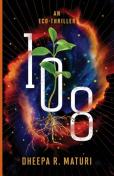BKMT READING GUIDES
108: An Eco-Thriller
by Dheepa R Maturi
Paperback : 412 pages
0 club reading this now
0 members have read this book
Introduction
Can one woman stop a chemical magnate from destroying life on Earth? While working the night shift at a San Francisco news agency, Bayla Jeevan has a shocking out-of-body experience. Her consciousness is transported deep into an Indian forest, where she witnesses a noxious liquid spreading through the soil. At the same time, she receives a message from her father, presumed dead for fifteen years, warning her of imminent danger. Coincidence? Unlikely.
Halfway around the world, agrochemical corporation ZedChem-led by billionaire Krakun Zed-tests its latest innovation, a product heralded as the solution to topsoil erosion. But the data reveals something else entirely.
As Bayla sets out looking for answers, she learns more about her past-and her family's connections to a secret organization with ancient roots and to Zed himself. Will Bayla be able to stop the corporation from ruining global agriculture and devastating human existence forever?
In this action-packed eco-thriller, the bonds of family-and the power to save Earth-are put to the test.
Editorial Review
No Editorial Review Currently AvailableExcerpt
C H A P T E R 1 B A Y L A September 2040—San Francisco, California ?The scent of jasmine caught Bayla Jeevan off guard. ?She never allowed herself to think about the land where she’d grown up, but here she was, daydreaming of axlewood groves and haldina plants and, yes, jasmine. And of a woman, unfamiliar and yet . . . Stop it, she scolded herself. Her eyes scanned the room. The interns sat working at their desks while the rest of the staff exited the Environment Wire news agency. Most were heading to La Cantina next door before going home. “Weren’t you here just a few nights ago?” Braden Turner had stepped out of his glassed-in office and was looking at her with concern—or was it amusement? She winced. “Someone needed to switch. It’s okay—really.” “Well, keep an eye on the board.” He tipped his head to indicate the electronic monitor mounted nearby. Originally installed to track fire activity in Northern California, it now showed an office-evacuation prompt at least once a week.DHEEPA R. MATURI The overhead purifiers kicked into high gear as they la- bored to scrub the day’s accumulation of toxins from the of- fice air. Bayla jerked her thumb toward the EtherScreens and spoke loudly: “I’d better . . .” Braden answered through the din. “Yep, go ahead. See you in the morning.” She nodded and turned away, making a show of adjusting the EtherScreen projections but watching from the corner of her eye as Braden walked toward the door. For the next eight hours, she’d be working alone. Bayla scanned the screens. Taking in twenty-four ro- tating screens of environmental data at once required sharp concentration, but she was used to it. A few times per month, midlevel researchers like her monitored overnight informa- tion and siphoned it to the appropriate interns. They, in turn, pushed their findings up the writing and editorial chain. Bayla’s hands flowed through the air in front of her. The EtherScreen technology allowed her to manipulate the dis- plays and information by gesture alone, with no physical touch required. On one screen to her left, the Global Monitoring Lab re- leased the latest spikes in atmospheric carbon dioxide over the Arctic Circle. That was Ethan’s area. She swept the data to him for examination. She grimaced at eyewitness photos of New Yorkers skir- mishing around bread trucks, attacking hapless drivers. Rani could handle that—sweep. Immediately, an e-zine headline popped up on the same screen: “NYC mayor’s office plants evi- dence of food crisis.” Sighing, she pushed it to the trash folder. On her right appeared the Census Bureau count of per- sons displaced from the South Florida coastline. Usually that information would go to Kwame, but Tara was already analyz- ing similar numbers along the entire East Coast. Sweep. The same display rotated to satellite images of the latest le- thal heat wave moving across South Asia. She flinched a little, then swept the information to Min-Lee. Minutes, then hours, slipped by as Bayla continued to re- view and sweep, review and sweep. When she began to yawn, she stood to stretch and ward off her sleepiness. There it was again—a whiff of jasmine. Stop it, she admonished herself, shaking her head in an ef- fort to push away the daydream. What had triggered it again? “Bayla!” Her eyes widened, and she sat down hard. She dug her fin- gernails into her forearm. That voice. Craning her neck, she looked around. At the far end of the floor, the interns sat bent over their desks. One was snoring, his head buried in his arms. The only other sounds were the hum of EtherScreen projections and the whir of air purifiers. “Bayla, we need you!” Yes—it was her father’s voice. She hadn’t heard it in fifteen years. Bayla gasped as the news agency blurred and faded, and she found herself standing amid dense foliage, heavy mois- ture pressing against her body. Fear gripped her belly, and her breathing accelerated. What’s happening? Where am I? Sounds, sights, smells began to populate around her. The call of cicadas. The trunks of banyans. The breath of jasmine. I know this place! She’d tried hard to forget it. She turned in a circle, absorbing familiar details of the land in which she’d spent the first twelve years of her life. Reaching out, she touched the bark of an axlewood tree, and then another, and another—she was inside a grove. Glancing at her hands, she gasped again. Threads of light emerged from them, connecting her to the tree she was touch- ing, and the next tree, and the next, entwining her with the entire grove. Looking down, she saw that they emerged from her entire body—arms, torso, legs, feet—and wove into all the other threads. Yet she didn’t feel restrained. The threads were bolstering, fortifying her. And they were familiar. This had happened to her before— but when? Before the memory could surface, the threads lengthened, then split like vines, moving in whatever direction she looked, joining her to everything she could see. “Bayla! Look down!” She obeyed without thinking, peering into the dark soil. The threads of light followed, pushing through the ground and interweaving with the root structures that anchored the grove and spread outward for miles. She bent and examined the in- dividual roots, perceiving the gossamer between them, lacing the whole system together. She smelled loam and life. Her fear could not coexist with the wonder of it all, this web of light surrounding her and extending both earthward and skyward. Closing her eyes, she listened. The web pulsed and reverber- ated, rendering its own music. Like the terrain, the music seemed familiar to her, and she rode the melodies like waves. “Bayla, we’re here.” She spilled out of the rise and fall of sound. We? Looking around at the web, she saw a tiny orb a few feet away from her, a point brighter than the threads surround- ing it. She looked down at her own body. She, too, existed as one sphere of light within the web. Concentrating, she peered around and saw more bright spots—only ten at first, then twenty, fifty, a hundred, maybe more. Somehow she knew: they were all people, just like her. But who were they? What did they want? “Bayla, we need you!” The bright spots united into one intention—striving and straining together, to do . . . something. Then she saw it—black liquid, thick and viscous, pour- ing and spreading all around her. It pooled and sank into the ground, burning as it went. She recoiled, because she felt it in her own body, too. The black liquid beaded around the threads and slid into her, piercing her skin, biting her bone. She dropped to her knees. The hiss of acid blurred the swell of song. The reek of smoke covered the scent of soil. Her vision became shadowed. “Now, Bayla!” She drew a ragged breath, focusing on the chaos around her. Suddenly, she understood. They—whoever they were— wanted to stop the liquid, and they wanted her help. But what could she do? She attempted to thrust her hands into the soil, to block the liquid and push it back, but she could no longer move. Fixed in place, she could only watch. No! she tried to shout, but her voice caught in her throat. It was too late. She watched the liquid push through land and water, bleeding farther and farther outward, past her line of sight. When at last her limbs jolted into motion, she collapsed to the ground. No, please, I can’t—I can’t bear this! Curling into a ball, she writhed, drawing rattling breaths and gripping the scorched soil around her. She looked up, shocked, as the soil cooled into laminate beneath her hands. The buzz of insects became the whir of air purifiers. She was surrounded again by EtherScreens. The threads of light had vanished. It had felt too real to be a dream. Could she have been physically transported to the forest? That makes no sense. The devastation and loss she’d witnessed flashed through her mind. Her gut lurched at the possibility—the certainty— that somehow she could have prevented it. And why—why my father’s voice?Discussion Questions
From the author:1. 108 takes place in the future. Did you find the future environment and descriptions of Bayla's day-to-day life intriguing, frightening, or something in between?
2. Though the story of 108 is fictional, environmental pollution is obviously real. How did the environmental theme make you feel—empowered, educated, frightened, inspired?
3. At the beginning of the novel, Bayla holds certain beliefs that influence her personality and behavior, for example, relationships only cause pain. What other beliefs does she hold? Why does she hold them? Which beliefs, if any, change by the end of the novel?
4. In what ways do Bayla and Chaadi feel trapped by the losses, grief, and abandonment they’ve experienced? How do those traumas impact their ability to function in their day-to-day lives? By the end of the novel, do they overcome their traumas, and if so, to what extent? How does Zed’s debilitating medical condition, as well as his emotional pain related to his brother and father, affect his philosophy of life?
5. At the midpoint of the story, Bayla is transported by van to the ZedChem facility—a pivotal moment for her personal journey. What realizations does she have in that moment, and how do they change her? What more does she need to learn before the end of the novel? Have you had similar moments of lucidity in your life, that demarcate a significant change from your past behaviors and/or personality?
6. Bayla fears Zed because he threatens her safety and that of her family, but also because he willfully refuses to consider the long-term consequences of his actions and business policies upon the planet. Why does the latter inspire fear in Bayla?
7. Much of ZedChem’s work is designed to drive sales while disregarding the impact of its products upon the environment. Should ZedChem have to consider its impact on human beings or the planet itself? In a capitalist society, is it possible to factor in the needs of the environment? What would conscious capitalism, which takes the needs of people and planet into account, look like?
8. Daksha is a powerful character operating outside typical social structures. Aatmanji has difficulty describing her and the source of her power, stating that she is "of Earth." What does it mean to be so deeply identified with the planet? In what ways does Daksha resemble Bayla, and in what ways do they differ?
9. Motherhood and mothering are complex topics in the novel. Bayla feels mothered by the Tula School community and indeed, by the forest itself. On the other hand, she doesn’t experience Daksha as a mother while growing up, but she does feel mothering energy when they are reunited. What actions constitute mothering? Can mothering occur outside a one-on-one human relationship? Can one mother a landscape? A community? A planet? What is the source of mothering energy, and what does it represent?
Book Club Recommendations
Recommended to book clubs by 0 of 0 members.
Book Club HQ to over 90,000+ book clubs and ready to welcome yours.
Get free weekly updates on top club picks, book giveaways, author events and more








